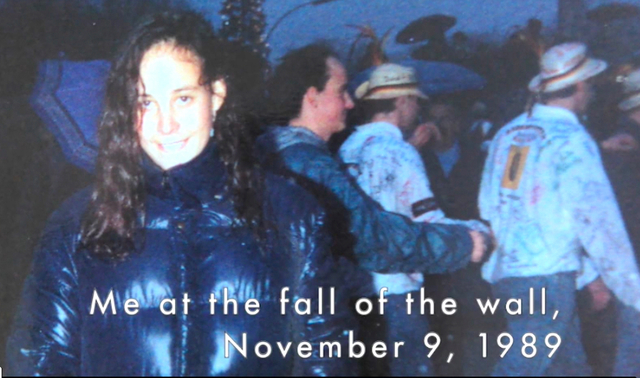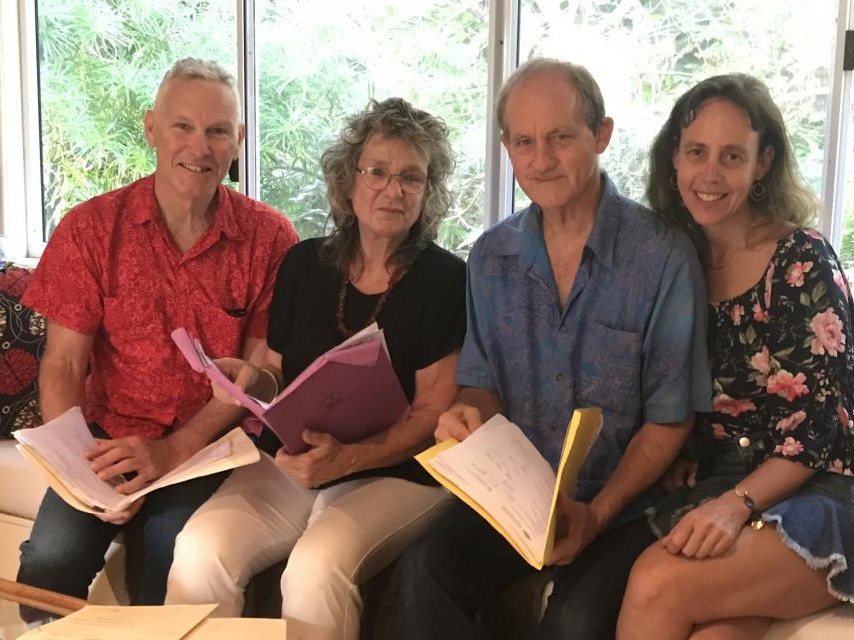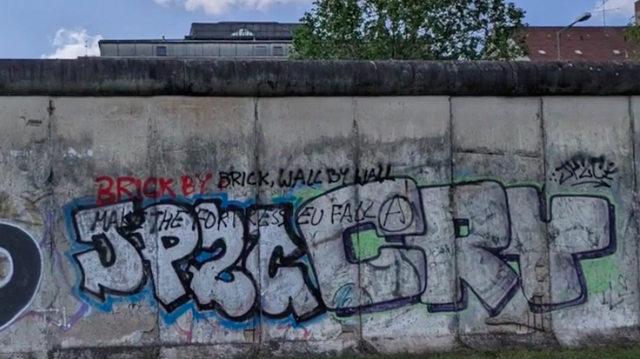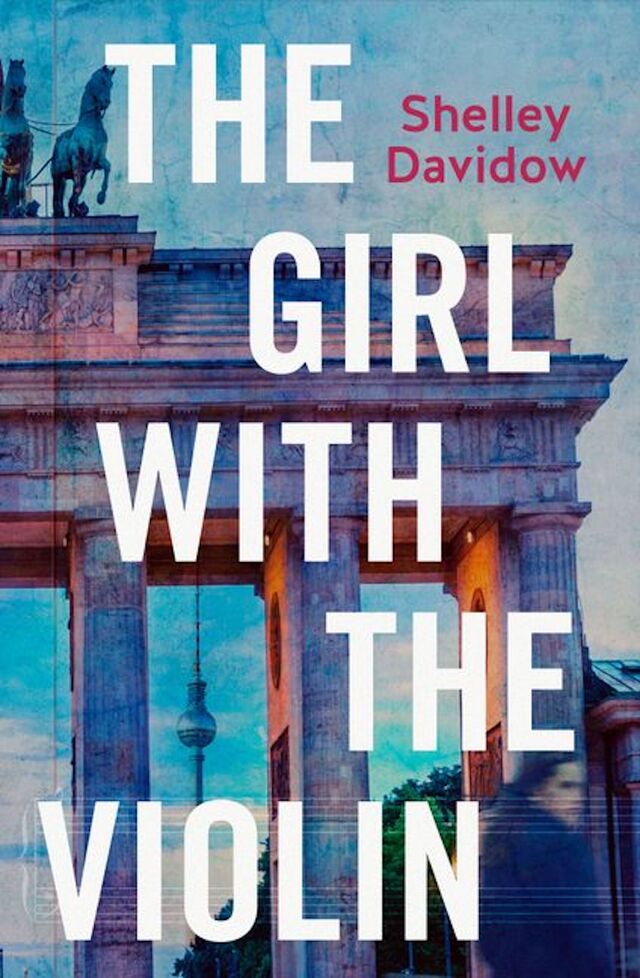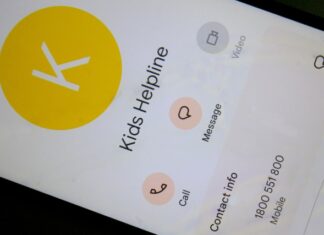They are as young as she is, those who now scramble up the wall—an activity which just the other day would have seen them shot. Ahead, a crane raises its steel arm and comes crashing down on a section of concrete. The Brandenburg Gate appears ghostlike through the rain beyond the wall, on the east side … A gust of wind threatens the umbrellas of those who hope to hold back the weeping November sky. People coalesce, thousands of raincoats glimmering in the floodlit night … Everyone in the city, East and West, wants to be here, at die Mauer, at this moment. A young man with a pickaxe hacks at the concrete, chipping
away. ‘Passt auf!’ Watch out!
Thus begins Sunshine coast academic and author Shelley Davidow’s remarkable new novel, The Girl With The Violin.
This is a work of fiction but the events, the mood of the crowd and the fear Davidow describes are as real to her now as they were that November night in Berlin in 1989, the night the wall came down, because the author was there, a frightened, trembling teenager a long way from home and inadvertently, accidentally, in the front row of history.
Screenshots from some blurry salvaged film shot that night, and now on Davidow’s website, show a pretty girl with rain-tangled hair, masking her fear with a faint, brave smile to camera. The image is enough to bring a tear to the eye of a father of adventurous girls, but it is not nearly as powerful as the author’s description, drawn from a gulf of half a Biblical lifetime, during which time she learnt how to write but not how to forget.
Seeing the fall of the wall through the eyes of her protagonist, Susanna, Davidow deftly draws us into the larger event unfolding around her, while building our interest in who she is and why she is there at the wall.
She writes: “People stack against each other like cards with no air between. She has never been in such a crowd. Her life in Australia has been defined by space and air and light. But now it’s almost too hard to breathe. People crush her from behind, from in front. She tries to suck in air and her ribs don’t expand … Will she die here in front of the Berlin Wall, a twenty-year-old Jewish Australian violin student, trampled to death by a stampeding crowd? It would make some kind of sense.”
We learn a lot about Susanna in these opening chapters, even down to her minor abnormalities, such as a haematoma on her left ring finger, an extra vertebrae (L6) and a strange extra half-rib. But while the author admits she shares all of these, she is quick to point out that Susanna and Shelley are not one and the same.
Davidow says: “How much of Susanna is me? Well, I don’t play the violin and I’m not at all of the same disposition, but I do have those quirky abnormalities she has, and I understand age gap relationships. I draw on personal experience to explore the dynamic and the complexities of the relationship she has with her violin teacher. I really enjoyed writing that because I like impossible love stories that dare to go into the grey areas.”
I am interviewing Shelley Davidow by phone from Melbourne, where she is reading Girl With The Violin for the talking book edition ahead of its publication next month. Although she has published 50 books, reading one aloud is a first for her. “I’ve learnt a lot,” she laughs, and I redirect her to my probing questions about the book, keenly aware that there is a fine line between exploring what lies between the pages and creating the need for a spoiler alert for readers.
She says: “I think what I also share with Susanna is the deep experience of geographic, emotional, psychological and even spiritual dislocation because I come from a long line of refugees who ran from something at one time or another. I’ve been running for a large part of my life. Susanna runs too but not nearly as much, from Australia to Germany and back to Australia, always running away from and towards something, and each time she loses part of herself. She is also a kind of wish fulfilment for me too, because I really wanted to be a violinist.”
Born in Johannesburg, South Africa in the time of Apartheid, Shelley saw as a schoolgirl the dislocation of people from their society and felt in her bones that this was her heritage too. She says: “It’s a difficult time to talk about my own refugee background because the mainstream media has decided that all Jews are bad guys, but I come from a line of Ashkenazi Jews who spoke Yiddish and originated in the Rhineland north of the Alps. When I went to Germany as an exchange student at 15 I learnt fluent German without an accent in just five months. I speak other languages without that level of fluency, and people often ask if my family is from Germany, which it’s not but I feel that strong hereditary connection.”
But the inciting event for what would become The Girl With The Violin came three years later, when she returned to Germany to visit her host family. She explains: “This family had rescued me from a bad situation and I went back to thank them. I went to Berlin with their 16-year-old daughter to visit her sister. We heard that the wall was coming down, so we went to see. I held her hand and off we went, and I thought I was going to die. Thoughts ran through my head, like I didn’t plan for this! Maybe I’m going to die on front of the Berlin Wall. There were so many people and there was so much anxiety. The people from the East were desperate to get into the West, and the people from the West were curious to see family members they hadn’t seen since 1961. There was a small gap in the wall and they were pushing through from both sides. I ended up in a crush, and beyond that there were young people climbing up onto the wall.”
The years rolled by and Davidow became a distinguished writer and academic, with some 50 publications to her credit, and lived and worked in many countries, but the experience of 9 November 1989 at the Berlin Wall never dimmed. She says: “I tried to write different versions of the elements of this novel, but all of them went dry. The experience of 1989 kept burning under my skin.”
After moving to Noosa with partner and fellow academic Paul Williams, she became a senior lecturer at University of the Sunshine Coast, and, with bookseller Annie Grossman and now-Noosa Mayor Frank Wilkie, she and Williams founded the Sunshine Coast Creative Writing Institute with the catchy tagline of “Write On The Coast”. In what spare time remained she published two acclaimed memoirs and worked up a few sample chapters of her Berlin book. With the publisher’s advance, in 2023 she went back to Berlin for the first time since 1989.
She recalls: “The last time I had stood in front of the Brandenburg Gate was 35 years earlier. It was such a contrast, a beautiful early summer day, but it felt like no time had passed, that I was standing on the west side in ’89 in the rain and the cold and listening to the desperation of the crowd. This time I was on the opposite side of where the wall had been, in absolute tranquility, with no echoes of the past. But it still felt like a place of shadows and light. There’s so much that is disturbing about what happened there, and so much that is inspiring in terms of the art and the people.
“I couldn’t anticipate what I found when I went back because it transcends the physical. Most of the conversations in the book with East Berliners are based on real conversations I had last year, and what I found was that somehow there was a sense of loss that reunification had caused, that what they had, had been replaced by the consumerism of the West. There’s a narrative about the East that simply doesn’t ring true for them.”
There is a complex, intricate and international love story running through this cracker of a novel, but underlining it is a deep sense of time, place and culture, and how society endures. As Davidow says: “There are levels of meaning to the falling of the wall that you can never appreciate unless you were there, and if you were, they never leave you.”
The Sunshine Coast launch of The Girl with the Violin will feature two amazing women on violin, performing pieces from the novel. There will be a two-course dinner (with wine) and Shelley Davidow will be in conversation with Sally Piper.
Sunshine Beach Surf Life Saving Club, 4 July, 6pm, $90.
To book, call Annie’s Books on Peregian at (07) 5448-2053.


